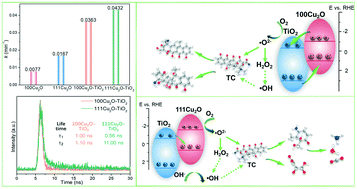Enhanced photocatalytic degradation of tetracycline by constructing a controllable Cu2O–TiO2 heterojunction with specific crystal facets†
Abstract
A heterojunction photocatalytic system has been widely called for to solve tetracycline (TC) water pollution problems. However, the pollutant degradation mechanism with a Z-scheme or double-charge transfer photocatalyst has remained ambiguous. In this work, we successfully constructed a controllable heterojunction between TiO2 and Cu2O by adjusting the exposed facets of Cu2O without additional surfactant. XPS, FT-IR, EIS, PL, EPR, LC-MS, photocurrent curves and scavenger experiments, as well as XRD characterization before and after photocatalysis, demonstrate that the heterojunction with double-charge transfer mechanism exists between TiO2 and cubic Cu2O exposed {100} facets (100Cu2O), where electrons diverted from 100Cu2O to TiO2 by O atoms to enhance the TC photocatalytic degradation rate. However, the complete decomposition of TC intermediate products was attenuated as the TC degradation reaction was drifted on the more positive conduction band of TiO2. Instead, Z-scheme heterojunction between TiO2 and octahedral Cu2O exposed {111} facets, (111Cu2O) was formed where electrons moved from the conduction band of TiO2 to the valence band of 111Cu2O by Cu atoms. Thereby, TC degradation occurred at the conduction band of 111Cu2O, which enhanced the TC photo-degradation rate and the profound decomposition of TC intermediate simultaneously. We expect that this work can contribute to the prospective application of heterojunction for the photocatalytic degradation of antibiotics.



 Please wait while we load your content...
Please wait while we load your content...